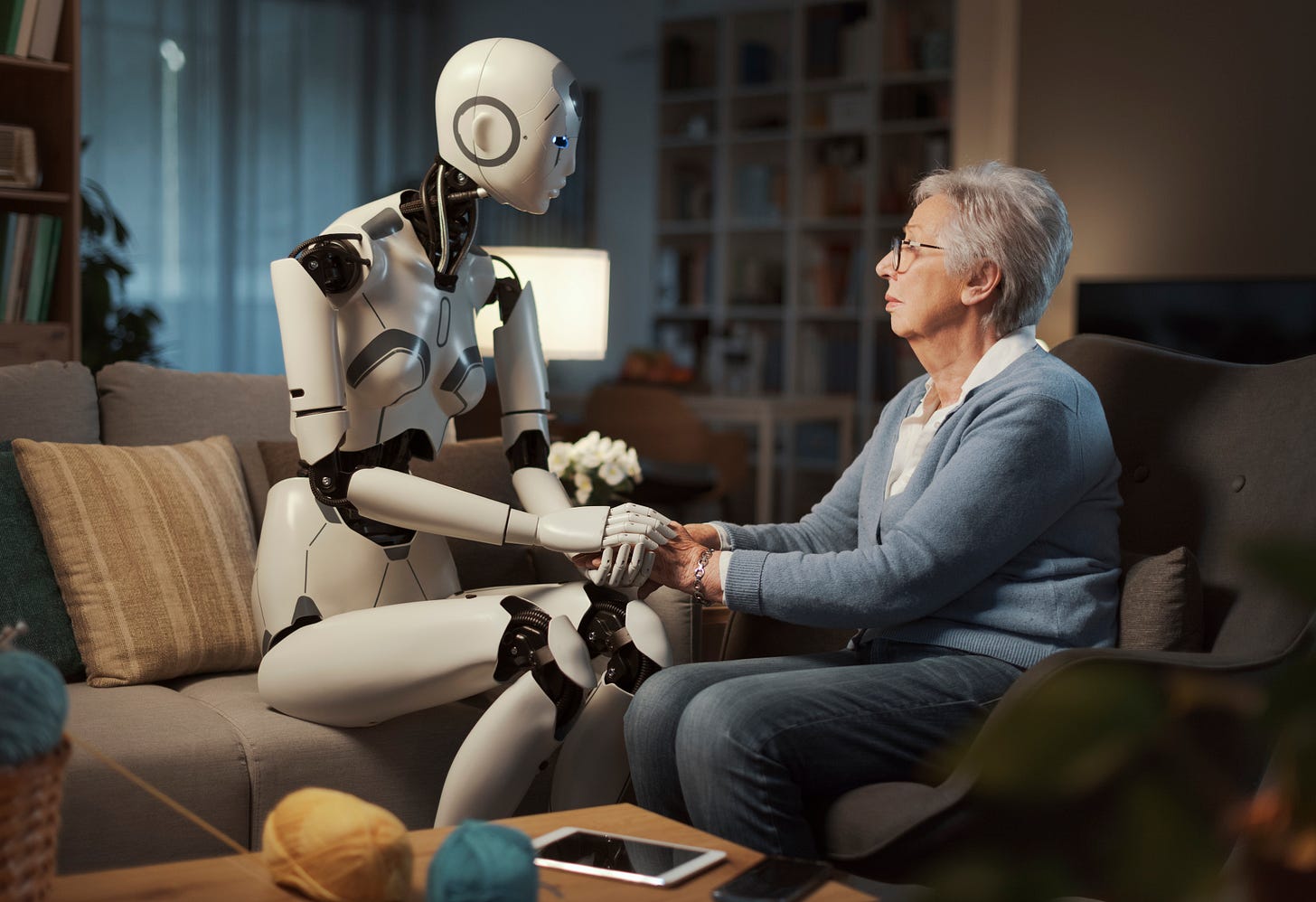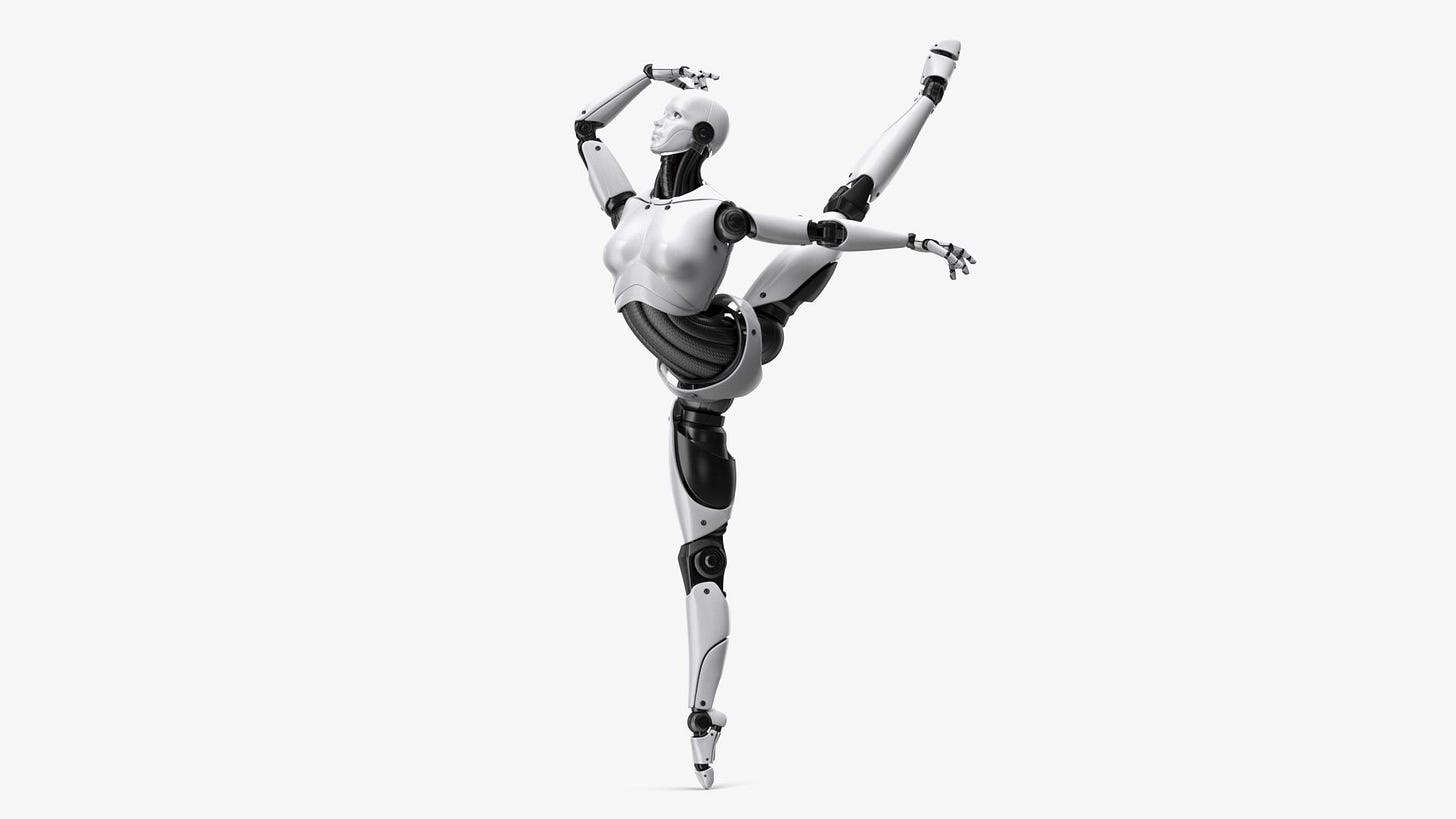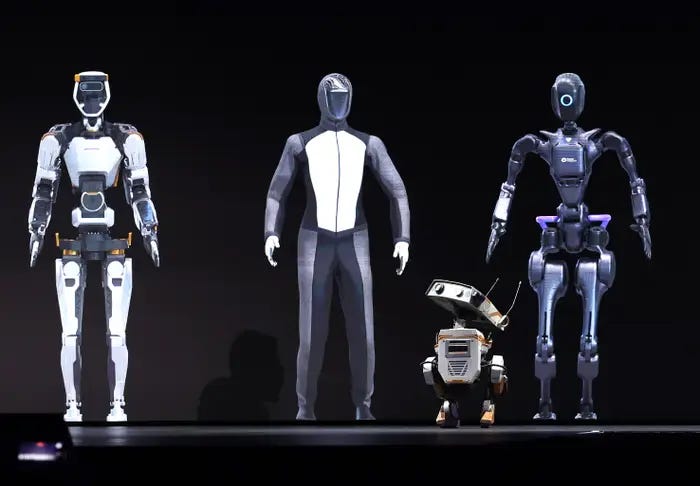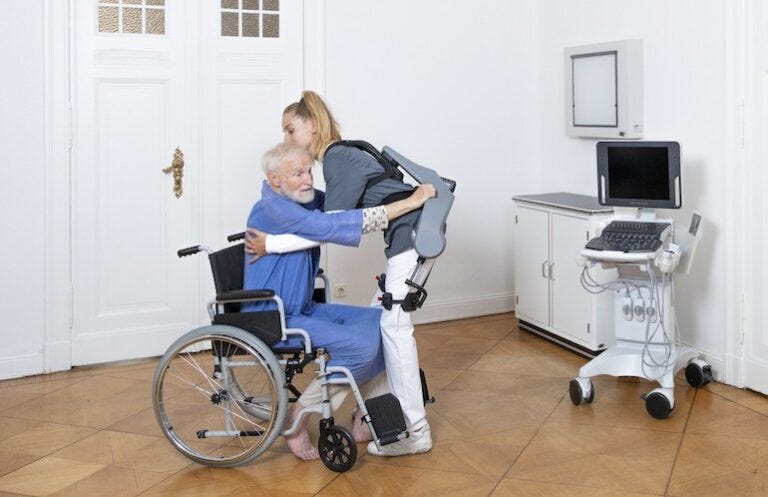Not Your Average Robot: Building a Safer Future for Humanoids
Building ethical, stable, and human-centered robots—one standard at a time.
Aaron’s Thoughts On The Week
“We shape our tools and thereafter our tools shape us.” — Marshall McLuhan
When I started working on looking into the need for humanoid standards, I never expected I’d spend quite so much time thinking about how they fall.
And yet….here we are.
For the past 12 months, I have had the privilege of leading the IEEE Humanoid Study Group. This past week, the team released its Executive Summary on standards for humanoid robots: “Robots in Human Spaces: Building Standards for Safe, Ethical, and Effective Integration.” It’s the result of months of effort, over 70 contributors from academia, industry, government, and fellow standards bodies, and yes, many long debates over stability metrics, communication cues, and what it really means to be “humanoid.”
And let me tell you: it was worth every minute.
Humanoids Are Not Your Average Robot
If you’ve seen a humanoid robot in the news lately—maybe lifting boxes, giving tours, or waving awkwardly at a crowd—you might think, “Cool! But is it safe? And… why does it need to look like that?”
Those are the exact kinds of questions the team and our report tackle. Because humanoids aren’t forklifts with legs—they’re machines designed to move, communicate, and sometimes even emote in human spaces. That means they’re being dropped into workflows and environments designed for and populated by people.
That brings enormous potential. But also an enormous risk.
Humanoids raise expectations. People assume they’re smarter, more aware, and more capable than they often are. When those expectations don’t match reality, trust breaks down, and worse, accidents can happen.
That’s why our report takes a broad, serious look at everything from physical safety and cybersecurity to psychosocial impact and emotional intelligence. Because walking, talking robots might look friendly, but if they’re going to work with us, they need to be understood, consistent, and, yes, held to some standards.
Falling Gracefully Isn’t Just for Ballerinas
One of the most fascinating topics we tackled was stability. Unlike wheeled or stationary robots, humanoids walk, and walking means falling is always a possibility. That’s not something current robotics safety standards are really built for. Most current standards assume the robot stays put, or if it is mobile, it is more than likely multi-wheeled and stable.
So we asked: What does stability actually mean for a bipedal robot? How do you measure it? How do you define safe behavior when something inherently unstable is operating in your workspace, or when walking past your toddler in a hallway?
It turns out that you can’t just port over the standards we have. We need performance-based, behavior-driven stability requirements that account for real-world motion, environmental disturbance, and even power loss. In other words, robots that can fall safely.
The Study Group will continue to explore this topic after the report. The goal will be to work with researchers and humanoid manufacturers to develop methodologies that support safety standards and address this issue. The question isn’t when your robot is going to fall, but how it will fall in a way to minimize risks to people, pets, other objects, and itself.
This will be an excellent opportunity to address one of robotics’ greatest challenges moving forward.
HRI: It’s Not Just Beeps and Blinks
Another highlight of this report was the in-depth exploration of human-robot interaction (HRI), as when a robot resembles a person, its behavior is particularly significant.
Our HRI team gathered insights from user interviews and surveys that revealed a recurring theme: people expect these robots to understand them. To communicate clearly. To recognize emotions. Even to apologize.
That might sound like science fiction, but in caregiving, education, or public-facing roles, these aren't extras. They’re essentials. If your elderly parent is being helped by a humanoid, it had better communicate clearly and respond with empathy.
That’s why we’re pushing for standards that go beyond just functional communication (lights, beeps, voice commands) and into emotional and contextual intelligence, and making sure robots don’t give off misleading cues they can’t follow through on.
There will also be a need for solid research to support those standards. As I told a reporter, “I think HRI experts are about to get very popular.”
Social scientists who want to get into Robotics, your time has arrived.
Classification: Because “Humanoid” Means a Lot of Things
One of the most challenging questions we faced? What even counts as a humanoid robot?
Is it about having two legs? A face? Just arms? A vibe?
Spoiler: it’s complicated.
To cut through the ambiguity, the team proposed a multi-dimensional classification system based on such key features as mobility, manipulation, communication, and specific use cases such as industrial, public, or home, not just whether the robot “looks” human. This framework will help clarify what a robot can do (and not do), where it can safely operate, and what kind of oversight it needs from regulatory agencies.
This isn’t just semantic. A solid classification system is the bedrock for future safety, performance, and ethical standards. Without it, we risk lumping together vastly different machines and missing the nuance that could keep people safe.
A Call to Action (and Maybe a Nudge)
Here’s the real heart of it: humanoid robots are entering public spaces now. Not in five years. Not just in movies. They're in warehouses, hospitals, airports, shopping malls, and even museums.
And they’re only going to get more capable, more mobile, and more present.
We can’t wait until things go wrong to figure out how to make them right. The group’s report is an early but essential step, drawing on the brains and insights of roboticists, ethicists, standards experts, designers, and yes, real-world users, to shape a roadmap that’s practical, technical, and human-centered.
The full version of this report is coming this summer and is free to everyone. It will go even deeper into the research, recommendations, and test protocols we believe are needed to support a safe and ethical humanoid future.
Until then, I’m incredibly proud of the work this team did. The real credit goes to the 70+ experts who contributed. I hope that it inspires action, not just from standards bodies, but from developers, designers, regulators, and the public.
Because humanoids may be built to serve, but it’s up to us to make sure they do so safely, ethically, and for the benefit of all.
Now, if you’ll excuse me, I need to go write a new standard for what to do when your robot trips over your dog.
Stay tuned.
Robot News Of The Week
Veho and RIVR team up for wheeled, legged robot parcel delivery pilot
Veho Tech and Swiss robotics firm RIVR have launched a pilot program in Austin using legged-and-wheeled delivery robots to tackle real-world e-commerce deliveries—including stairs, porches, and rough terrain.
Each robot can deliver up to 200 packages a day and works alongside human couriers, enhancing efficiency without replacing jobs. The tech aims to ease last-mile challenges in dense urban areas where parking and access are tough.
This marks RIVR’s U.S. debut and a big step toward scaling its human-centered delivery model. More cities may be following.
Torc Robotics opens first autonomous hub in Texas
Torc Robotics has opened its first autonomous trucking hub in Fort Worth, Texas, as it gears up to launch self-driving freight services along I-35. The 22,000 sq. ft. facility will support fleet operations, testing, and customer experience as the company targets a 2027 U.S. market debut.
The hub anchors Torc’s shift from Albuquerque to Dallas and will help scale its partnership with Daimler Truck. The move positions Torc to compete with other AV players like Aurora already active in Texas.
German Bionic unveils Exia AI-augmented industrial exoskeleton
German Bionic just launched Exia, its most advanced exoskeleton yet, powered end-to-end by augmented AI. Designed for industries ranging from healthcare to logistics, Exia adapts to its user in real-time, learning from movement patterns and offering up to 84 lbs of lift assist.
Unlike bulky exosuits of the past, Exia is smart, sleek, and continuously improving via software updates. With motion-tracking, safety alerts, and a user app for coaching and feedback, it’s built to prevent injuries, boost productivity, and extend careers in demanding jobs.
Exia is now available for pilot and fleet orders in North America.
Robot Research In The News
Scientists make robots that can walk straight out of the printers that created them
Researchers at the University of Edinburgh have developed a 3D-printed, soft-bodied robot that can walk straight off the print bed—no assembly required. Unlike earlier models, this air-powered quadruped can be printed in just 9 hours using an open-source, $500 Flex Printer made from off-the-shelf parts.
The team overcame challenges with the soft TPU material by using a thicker filament and printing upward instead of downward, allowing gravity to aid in layer fusion. Once printed, the robot walks using compressed air that powers actuators in its legs.
While still a demo, this open-source breakthrough could accelerate the real-world applications of soft robotics in medicine, search and rescue, and more.
Smarter, Cheaper Navigation for Ocean Robots
Northeastern researchers have developed an open-source algorithm that dramatically improves the accuracy of underwater robot navigation using low-cost acoustic sensors. Traditionally less reliable than GPS-like systems, acoustic sensors estimate distance but not exact location. The new algorithm removes this ambiguity—providing reliable position estimates at a fraction of the cost.
This breakthrough could make ocean exploration and climate research more accessible, especially in dangerous or remote areas like melting Arctic ice. The goal? Give scientists dependable, affordable robots to study the parts of our planet we can’t safely reach.
Robot Workforce Story Of The Week
King's College to expand pioneering robotics competition for girls
King’s College London is scaling up its Girls Robotics Challenge, thanks to a £30,000 grant from the Royal Academy of Engineering. The competition—UK’s first of its kind for girls and non-binary students—focuses on space-themed robotics challenges to boost STEM confidence and representation.
With the new funding, the program will grow from 5 to 12 school teams, reaching 96 students, particularly from underserved areas outside London. Events include a launch day, Hack Day with real engineers, and a final Challenge Day in April 2026. Travel bursaries and a new educational resource pack will further broaden the initiative’s impact.
Robot Video Of The Week
This week’s must-watch? A legged robot that actually plays badminton—and not just wobbling around either. Using a fully integrated visuomotor control system powered by reinforcement learning, this agile bot can track a shuttlecock, move across the court, and land solid shots against human players!
The robot coordinates legs, arms, and vision in real time—think robo-athlete meets action-figure precision. Trained with noisy camera data to mimic real-world conditions, it even learns how to actively adjust its perception for better strikes.
Is it the future of robot sports? Maybe. Is it awesome to watch? Absolutely.
Upcoming Robot Events
June 9-13 London Tech Week
June 17-18 MTC Robotics & Automation (Coventry, UK)
June 30-July 2 International Conference on Ubiquitous Robots (College Station, TX)
Aug. 17-21 Intl. Conference on Automation Science & Engineering (Anaheim, CA)
Sept. 3-5 ARM Institute Member Meetings (Pittsburgh, PA)
Sept. 15-17 ROSCon UK (Edinburgh)
Sept. 23 Humanoid Robot Forum (Seattle, WA)
Sept. 27-30 IEEE Conference on Robot Learning (Seoul, KR)
Sept. 30-Oct. 2 IEEE International Conference on Humanoid Robots (Seoul, KR)
Oct. 6-10 Intl. Conference on Advanced Manufacturing (Las Vegas, NV)
Oct. 15-16 RoboBusiness (Santa Clara, CA)
Oct. 19-25 IEEE IROS (Hangzhou, China)
Oct. 27-29 ROSCon (Singapore)
Nov. 3-5 Intl. Robot Safety Conference (Houston, TX)
Dec. 11-12 Humanoid Summit (Silicon Valley TBA)










